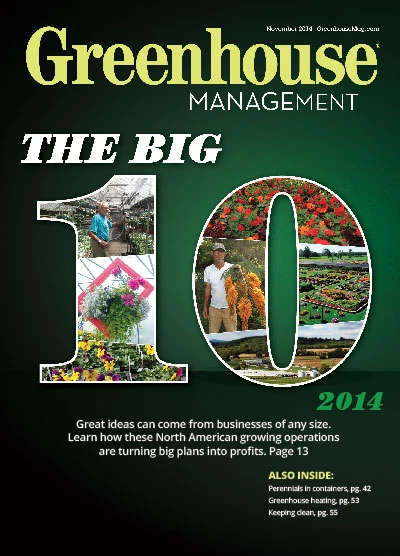 Up in Wayland, Mass., it’s not unusual to be buried under snow during a good portion of the year. However, as the snows begin to thaw, customers at Russell’s Garden Center, a grower-retailer there, can see some green popping up through the glass, and there’s no “Keep Out” sign on the greenhouse doors.
Up in Wayland, Mass., it’s not unusual to be buried under snow during a good portion of the year. However, as the snows begin to thaw, customers at Russell’s Garden Center, a grower-retailer there, can see some green popping up through the glass, and there’s no “Keep Out” sign on the greenhouse doors.
Russell’s, established in 1876, has made many transitions through the years, starting out as a produce market, growing cut flowers for wholesale, to now growing annuals and perennials for retail sale at their own store. The greenhouses on the property were built in the ‘40s, ‘50s and ‘70s.
One of the aspects of Russell’s that makes it stand out from other growers is that the company welcomes customers into the growing greenhouses to select their plants, rather than limiting them to a specific retail area out in the garden center.
“It was definitely a challenge to get going or to open up our minds — and the customers do seem to like that glimpse behind the screens — but that helps kind of educate them as to how this all works, too,” says Tim Skehan, co-owner and husband to fourth generation co-owner Elizabeth Russell-Skehan. “I remember when we first started doing it my grower said, ‘We can’t possibly do that.’” Another grower down the street that wholesales plant material does not allow the public in the greenhouse, which is typical in most places.
The idea began in the ‘80s with Elizabeth’s father, Lewis Russell. At the time, they were growing the plants in the greenhouses on the east end of the property and then transporting them on carts or in a van over to the retail yard to the west. It was an ineffective use of time and resources, so they decided to try combining the two parts of the business and letting customers in to see what would happen.
One of the challenges of throwing open the doors, so to say, has been that Russell’s can’t apply certain chemicals due to their re-entry times, which would mean periodically closing off their combined growing/retail space. So they’ve gone organic to avoid the problem altogether. Another issue is that some customers will pick up recently planted seedlings that should really spend some more time in the greenhouse before being sold. However, as long as they understand what they’ve got and that it will still need some TLC when it gets home, they can still purchase the plant. Some customers choose to come back later for it or perhaps grab a larger plant.
But it turned out to be a positive move for the company, in spite of its challenges. “For as much as you might find someone in high heels or expensive shoes, there are other people that are just spelunking in the back and they love it,” Skehan says. “They feel like they’re getting a behind-the-scenes look, because Americans are all about ‘What’s going on over there?’”
Customers can also see that they’re directly supporting a local grower, and they can see annuals and veggies earlier in the season because Russell’s is growing them rather than buying them in. And seeing greenery while there’s still snow on the ground is pretty appealing. Skehan says from the customers’ point of view, “You feel like you’ve got the least expensive vacation you’ve ever had and you can go there every week.”
Being a grower-retailer comes with its own set of advantages and challenges. Skehan says that one of the high points is being able to choose what they would like to grow for the retail part of the business. “We’re known for [our plant] selection, so if there’s something that either we can’t find out on the market, or if we want to go deeper on something, I’ve got knowledgeable people here that can actually make that happen,” he says. “So we have the really unique [products]… and it gives us some flexibility.”
However, they’re greatly limited in what they can grow due to their location. While their property stretches over 30 plus acres, it’s located in a flood plain. If the waters get too high, they close the main road that the operation is on, which also goes through the center of town. It also means that they’re not able to overwinter any plants, since the floodwaters tend to come through from January through early spring. “It seems like every seventh year we get 10 inches or 2 feet of water in our greenhouses,” Skehan says. “We consolidate down to a very small footprint in the winter.” So they’re limited to growing annuals (including color, veggies, herbs and poinsettias) and everything has to be grown on tables/benches in case the waters rise again. But one thing is for sure — after 138 years in business, Russell’s knows how to adapt and stay relevant to keep the business strong.

Explore the November 2014 Issue
Check out more from this issue and find your next story to read.
Latest from Greenhouse Management
- 2025 Proven Winners Horticulture Scholarship applications now open
- How to improve inventory and shipping management in the greenhouse
- Leading Women of Horticulture: Anna Ball, Ball Hort, and Terri McEnaney, Bailey Nurseries
- GM CEA HERB Part 2: A guide to increasing the sowing density of culinary herbs
- GM CEA HERB Part 1: Best practices for producing culinary herbs in controlled environments
- USDA fires experts on invasive pests, including Asian citrus psyllid, chilli thrips
- CEA Alliance celebrates bipartisan introduction of Supporting Innovation in Agriculture Act
- Dümmen Orange North America celebrating 25th anniversary in 2025








